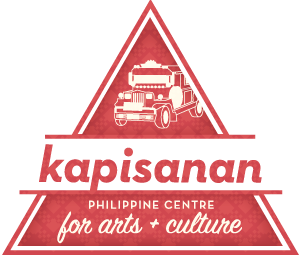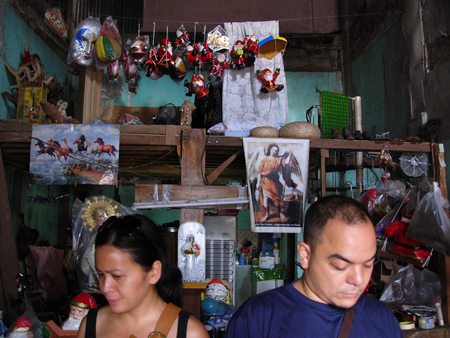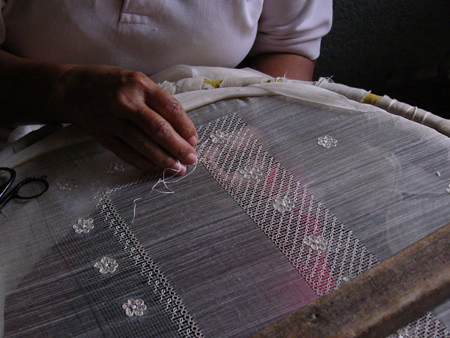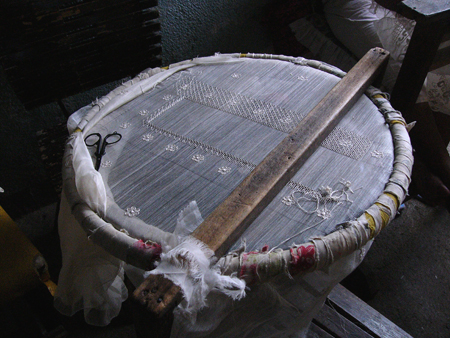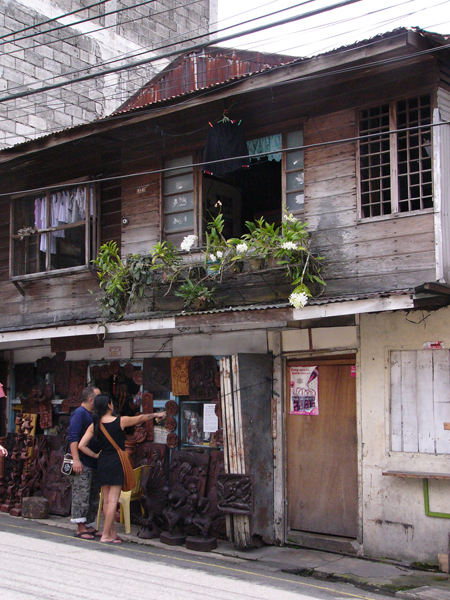 I'm on the road again with Caroline and Carlos. We head south, driving through small towns outside the city, stopping for fresh buko juice, lanzones, quesong puti, and crafts-all-you-want. We drop by to see the wood carving in Paete, Laguna where they also do a lot of papier-mache. It's a quaint little town with carved Catholic saints and parachuting Santas all year round.
I'm on the road again with Caroline and Carlos. We head south, driving through small towns outside the city, stopping for fresh buko juice, lanzones, quesong puti, and crafts-all-you-want. We drop by to see the wood carving in Paete, Laguna where they also do a lot of papier-mache. It's a quaint little town with carved Catholic saints and parachuting Santas all year round.
But we've really come to Laguna to visit Lumban which is famous for their intricate embroidery. Other towns like Taal in Batangas, Molo in Iloilo, Bocaue and Santa Maria in Bulacan are also famous for their handiwork, but Lumban is the "embroidery capital".
We have a long-standing love affair with embellishment. In the 1850s, embroidery, calado (or "cut out" work on the fabric), suksok (a design pattern woven into the fabric), and pleating became fashionable embellishments for the barong talagog. Generations of men and women in Lumban, Laguna have supplied the rest of the Philippines with its gorgeous embroidery over the last century.
They do fine work here. In Lumban, the embroidery process requires a lot of skill and a mountain of patience. It starts with pagpinta ("painting") or pagguhit ("drawing"), which is the design drawn in its actual size on the fabric, then the pagburda ("embroidering") which is usually combined with the calado work that highlights the embroidery. After this, the fabric is washed (paglaba), and then stretched (pagbanat) and dried under the hot Philippine sun. (It was raining in Lumban when we were there, but it certainly didn't stop them from production. Some embroiderers work in their own homes, while others gather in a production area that's usually someone else's garage.)
Embroidery I find fascinating. I adore doilies, sadly I have no talent or inclination for needle crafts. But I can certainly appreciate it and its evocative language reminds me all over again of the richness of our culture. The Pinuso (from the word puso or "heart") motif is made up of tiny heart-shaped leaves, buko is small dots, kadena is a chain, and the sulsing abot-abot is the running stitch. I've read that somewhere in the collection of the Victoria and Albert Museum in London, there's an embroidered pineapple fiber handkerchief from the Philippines, circa 1863. After seeing the embroidery they are doing in Lumban, I'm not at all surprised Queen Victoria had a panyo from the Philippines.
To this day, the demand for embroidery is still fairly high and business in Lumban is good. According to our contact, hand embroidery cannot be rushed and it takes at least a month to finish the painstaking work. But the results are beautiful--and definitely worth the wait.
